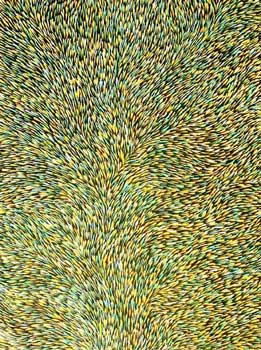Rose Tasker
Adelaide, Australia
 |
| Leaves Gloria Petyarre (1945 -) |
The leaves of the Kurrajong, or Kurrawong tree (Brachychiton1) have been captured in several paintings by Australian Aboriginal women artists. These stylistic and iconic paintings first gained international attention in 1999, when one work by Gloria Petyarre (1945 – ) won the Australian “Wynne Prize” for landscape. Pictured here, the winning piece, ‘Leaves’, was a large 122 cm x 93 cm green and gold painting featuring the medicine leaves of the Kurrajong tree. An intricate pattern of thousands of leaves, each beginning as a fine dot and ending with a tapering tail, seemed to create movement across the landscape.
The leaves of the Kurrajong tree have been collected for thousands of years by Australian Aboriginal women to be used in traditional bush medicine. There are thirty-one species of the tree, and it can be used to treat ailments such as headaches, coughs, pain, colds and fever, gastrological problems, wounds, and stings. Women are the custodians of this ancient healing knowledge, which is passed down through generations.
The color of the leaves varies with the species and seasons, and this is depicted in the artworks. Medicine leaf paintings feature a range of hues and colors. They have been described as mesmerizing, bringing to mind grass blowing in the wind, leaves being blown across the grown, and seaweed swirling and pushed against the tide. Because of the healing and medical themes these paintings reflect, medicine leaf paintings are often found hung in consulting rooms and medical practices both in Australia and internationally.
Gloria Petyarre is recognized as the pioneering artist of the bush medicine leaf painting style, although her cousin Jeannie Petyarre also claims to be the first. Other Aboriginal artists known to use this style and create medicine leaf paintings include Rosemary Petyarre, Margaret Scobie, Louise Nummina, Fabrianne Peterson, Caroline Numina Panaka, Janet Golder Kngwarreye, Abie Loy Kemarre, and Selina Numina.
Reference
- Schott, H.W. & Endlicher, S.F.L. 1832. Meletemata Botanica: 34.
ROSE TASKER is Doctor of Philosophy candidate at Torrens University in Adelaide, Australia. She is currently exploring disease and illness in artworks and craft objects under the guidance of a research fellow at the National Institutes of Health.
Highlighted in Frontispiece Spring 2015 – Volume 7, Issue 2
Spring 2015 | Sections | Art Flashes

Leave a Reply